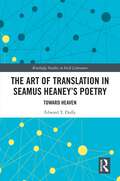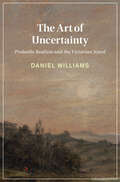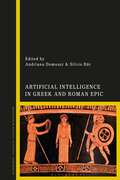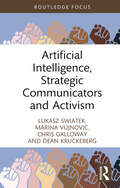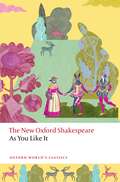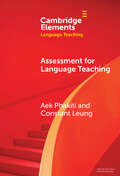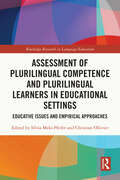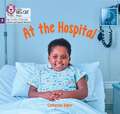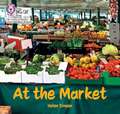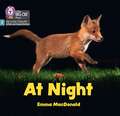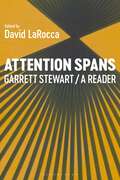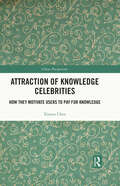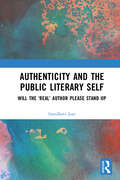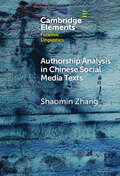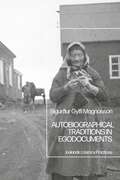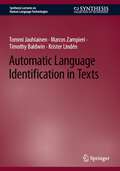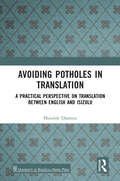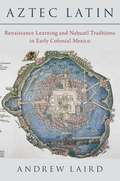- Table View
- List View
The Art of Translation in Seamus Heaney’s Poetry: Toward Heaven (Routledge Studies in Irish Literature)
by Edward T. DuffyThe Art of Translation in Seamus Heaney’s Poetry is a critical study of the poet's later work. While exploring his practice as a translator, it also traces his increasing preoccupation with the possibilities and conditions of translation in the theological sense of being lifted up in spirit. To the work of this philosophical poet, who would be both “earthed and heady” this book brings the insights of ordinary language philosophy as practiced by Stanley Cavell. It devotes separate chapters to Station Island and three later collections: Seeing Things, Electric Light and Human Chain. The first of these addresses the most fundamental change in Heaney’s life when he acknowledges the “need and chance to re-envisage” his Irish-Catholic upbringing; it is also replete with both the activity and the trope of translation. Published seven years later, Seeing Things begins with a translation of Virgil’s golden bough episode and ends with a similar crossing over into the underworld by Dante. Heaney transforms both into poems about poetry. In Electric Light, Heaney returns to Virgil, but now he concentrates not on the hero of the Aeneid but on Virgil's earlier efforts in pastoral, a mode of writing that Heaney takes as a model for his own time and place of “devastated order.” Heaney returns to the Aeneid in Human Chain, but this time around he gives all his attention to the scene of the human souls in Elysium seeking rebirth and turns it into an image for the need and chance of pronouncing “a final Yes” to our world and our place in it.
The Art of Uncertainty: Probable Realism and the Victorian Novel (Cambridge Studies in Nineteenth-Century Literature and Culture)
by null Daniel WilliamsThe Victorian novel developed unique forms of reasoning under uncertainty-of thinking, judging, and acting in the face of partial knowledge and unclear outcome. George Eliot, Wilkie Collins, William Thackeray, Thomas Hardy, and later Joseph Conrad drew on science, mathematics, philosophy, and the law to articulate a phenomenology of uncertainty against emergent models of prediction and decision-making. In imaginative explorations of unsure reasoning, hesitant judgment, and makeshift action, these novelists cultivated distinctive responses to uncertainty as intellectual concern and cultural disposition, participating in the knowledge work of an era shaped by numerical approaches to the future. Reading for uncertainty yields a rich account of the dynamics of thinking and acting, a fresh understanding of realism as a genre of the probable, and a vision of literary-critical judgment as provisional and open-ended. Daniel Williams spotlights the value of literary art in a present marked by models and technologies of prediction.
Artificial Intelligence in Greek and Roman Epic
by Andriana Domouzi and Silvio BärThis is the first scholarly exploration of concepts and representations of Artificial Intelligence in ancient Greek and Roman epic, including their reception in later literature and culture. Contributors look at how Hesiod, Homer, Apollonius of Rhodes, Moschus, Ovid and Valerius Flaccus crafted the first literary concepts concerned with automata and the quest for artificial life, as well as technological intervention improving human life.Parts one and two consider, respectively, archaic Greek, and Hellenistic and Roman, epics. Contributors explore the representations of Pandora in Hesiod, and Homeric automata such as Hephaestus' wheeled tripods, the Phaeacian king Alcinous' golden and silver guard dogs, and even the Trojan Horse. Later examples cover Artificial Intelligence and automation (including Talos) in the Argonautica of Apollonius and Valerius Flaccus, and Pygmalion's ivory woman in Ovid's Metamorphoses. Part three underlines how these concepts benefit from analysis of the ekphrasis device, within which they often feature. These chapters investigate the cyborg potential of the epic hero and the literary implications of ancient technology. Moving into contemporary examples, the final chapters consider the reception of ancient literary Artificial Intelligence in contemporary film and literature, such as the Czech science-fiction epic Starvoyage, or Small Cosmic Odyssey by Jan Kr?esadlo (1995) and the British science-fiction novel The Holy Machine by Chris Beckett (2004).
Artificial Intelligence, Strategic Communicators and Activism (Global PR Insights)
by Lukasz Swiatek Marina Vujnovic Chris Galloway Dean KruckebergIn a world that is increasingly wary of artificial intelligence (AI), this book explores the pressing need for strategic communicators to move away from being advocates for AI and move towards a more critical activist role that enables them to counter AI-driven threats to communities and relationships. AI is contributing to inequality, misinformation and environmental damage, among other problems. This book argues that strategic communicators are uniquely placed to help counter AI-driven challenges because of their skills in relationship-building and their ability to craft and deliver messages effectively. By discussing the different professional activist approaches that communicators can take in relation to growing AI challenges, the book offers multiple perspectives that will help to build knowledge in diverse settings and develop practice, especially in community and activist strategic communication. Research-based and combining theory with practice, this thought-provoking book will be welcomed by strategic communication scholars and practitioners alike eager to develop a critical approach to the challenges surrounding AI.
Artificial Intelligence, Strategic Communicators and Activism (Global PR Insights)
by Lukasz Swiatek Marina Vujnovic Chris Galloway Dean KruckebergIn a world that is increasingly wary of artificial intelligence (AI), this book explores the pressing need for strategic communicators to move away from being advocates for AI and move towards a more critical activist role that enables them to counter AI-driven threats to communities and relationships. AI is contributing to inequality, misinformation and environmental damage, among other problems. This book argues that strategic communicators are uniquely placed to help counter AI-driven challenges because of their skills in relationship-building and their ability to craft and deliver messages effectively. By discussing the different professional activist approaches that communicators can take in relation to growing AI challenges, the book offers multiple perspectives that will help to build knowledge in diverse settings and develop practice, especially in community and activist strategic communication. Research-based and combining theory with practice, this thought-provoking book will be welcomed by strategic communication scholars and practitioners alike eager to develop a critical approach to the challenges surrounding AI.
As You Like It: The New Oxford Shakespeare (Oxford World's Classics)
by William Shakespeare'We that are true lovers run into strange capers.' Four centuries after its publication in the Folio, As You Like It's capacity to entertain and instruct remains evergreen. This edition provides a friendly yet authoritative introduction to the play, upholding it as a crowning expression of the Elizabethan Renaissance while underscoring its appeal to twenty-first century readers as Shakespeare's most intrepid exploration of gender, sexuality, and the environment. Its double-cross-dressed heroine dominates the plot (and their love interest Orlando) to conduct a masterclass in gender fluidity. The melancholic Jaques unmasks the fundamental theatricality of existence and questions humanity's prerogative to displace and harm other species. Through the clown Touchstone, the comedy tests the possibility that we might laugh ourselves wise, especially when we learn to laugh at ourselves. In the Forest of Arden, we encounter Shakespeare's most beguiling vision of the natural world as a realm of serenity and harmony, while brushing up against the briars that puncture our fantasies of the simple life. The New Oxford Shakespeare offers authoritative editions of Shakespeare's works with introductory materials designed to encourage new interpretations of the plays and poems. Using the text from the landmark The New Oxford Shakespeare Complete Works: Modern Critical Edition, these volumes offer readers the latest thinking on the authentic texts (collated from all surviving original versions of Shakespeare's work) alongside innovative introductions from leading scholars. The texts are accompanied by a comprehensive set of critical apparatus to give readers the best resources to help understand and enjoy Shakespeare's work. ABOUT THE SERIES: For over 100 years Oxford World's Classics has made available the widest range of literature from around the globe. Each affordable volume reflects Oxford's commitment to scholarship, providing the most accurate text plus a wealth of other valuable features, including expert introductions by leading authorities, helpful notes to clarify the text, up-to-date bibliographies for further study, and much more.
Assessment for Language Teaching (Elements in Language Teaching)
by null Aek Phakiti null Constant LeungThis Element reviews the key foundational concepts, beliefs, and practices underpinning approaches to assessment in English Language Teaching. Exploring major concepts and practices through educational, social, and ethical perspectives, it offers theoretically informed and close-to-practice descriptions and up-to-date explanations of the affordances and limitations of different assessment approaches related to language teaching. This Element presents a cohesive and pragmatic framework that allows teachers to efficiently implement tests and assessments in their contexts.
Assessment of Plurilingual Competence and Plurilingual Learners in Educational Settings: Educative Issues and Empirical Approaches (Routledge Research in Language Education)
by Silvia Melo-Pfeifer Christian OllivierThis book addresses contemporary issues in the assessment of plurilingual competence and plurilingual learners. Offering theoretical and practical lenses, it contributes towards an integrated and holistic assessment of plurilingual competence and plurilingual learners. The book provides both theoretical considerations and empirical approaches around how the specificities of plurilingual learners can be considered when assessing their various competences. It covers topics relating to learners in a variety of plurilingual settings: from the education of adult immigrants, assessment of young refugees and assessment of students in school and university, to the assessment of plurilingual competence in foreign language education. Showcasing a wide range of international authors, the book provides cutting-edge research in the domain of multilingual foreign, second and heritage language assessment, and assessment of content knowledge of plurilingual students. It bridges the gap between the fields of language policies and practices, research on plurilingual competence, and assessment in language education. Providing new insights into a crucial and contentious issue, this volume will be an essential reading for researchers and postgraduate students in the fields of educational language policies, applied linguistics and multilingualism, in particular those involved in the assessment of plurilingual competence.
Assessment of Plurilingual Competence and Plurilingual Learners in Educational Settings: Educative Issues and Empirical Approaches (Routledge Research in Language Education)
by Sílvia Melo-Pfeifer Christian OllivierThis book addresses contemporary issues in the assessment of plurilingual competence and plurilingual learners. Offering theoretical and practical lenses, it contributes towards an integrated and holistic assessment of plurilingual competence and plurilingual learners. The book provides both theoretical considerations and empirical approaches around how the specificities of plurilingual learners can be considered when assessing their various competences. It covers topics relating to learners in a variety of plurilingual settings: from the education of adult immigrants, assessment of young refugees and assessment of students in school and university, to the assessment of plurilingual competence in foreign language education. Showcasing a wide range of international authors, the book provides cutting-edge research in the domain of multilingual foreign, second and heritage language assessment, and assessment of content knowledge of plurilingual students. It bridges the gap between the fields of language policies and practices, research on plurilingual competence, and assessment in language education. Providing new insights into a crucial and contentious issue, this volume will be an essential reading for researchers and postgraduate students in the fields of educational language policies, applied linguistics and multilingualism, in particular those involved in the assessment of plurilingual competence.
Ästhetik des Anderen: Minoritäre Perspektiven in Literatur, Theater und (neuen) Medien (Interkulturalität. Studien zu Sprache, Literatur und Gesellschaft #24)
by Amelie Bendheim Jennifer PavlikWie werden Konzepte des Anderen in Literatur, Film oder Theater inszeniert? Die Beiträger*innen nehmen das Potential ästhetischer Formen in den Blick und reflektieren, wie diese dazu beitragen können, Ausschnitte der Wirklichkeit einsehbar zu machen, die oft unberücksichtigt bleiben: Perspektiven des Anderen. Jenseits von essentialisierenden Zuschreibungen geht es darum, Hybriditäten und Ambiguitäten offenzulegen, um verbreitete und mitunter erstarrte Denkmuster zu hinterfragen. Nur so kann eine differenzierte Welt- und Selbstwahrnehmung entstehen, die das Andere als fundamentale Erfahrung miteinbezieht und es als Möglichkeit zur Irritation und zum Staunen begreift.
At The Market: Phase 3 Set 1 (Big Cat Phonics For Little Wandle Letters And Sounds Revised Ser.)
by Helen Dineen Collins Big CatAt Night: Phase 3 Set 1 Blending Practice (Big Cat Phonics For Little Wandle Letters And Sounds Revised Ser.)
by Emma MacDonald Collins Big CatAttention Spans: Garrett Stewart, a Reader
by Professor or Dr. Garrett StewartAttention Spans' chronological review of Garrett Stewart's critical approach tracks and maps the evolution of intersecting disciplines from late New Criticism through structuralism, deconstruction, narrative theory (by way of narratography), poetics, and media studies, in which Stewart's has been so persistent and so eloquent a voice. Excerpts from his twenty books are framed by editorial retrospect, then linked by Stewart's own commentary on the variety – and underlying vectors – of his interpretive career across aesthetic forms, from Victorian narrative to recent American fiction, classic celluloid cinema to postfilmic digital effects, inert book sculpture and literary wordplay to the soundscape of singing on screen. Accompanied by a glossary of his many influential coinages, this cornucopia of analyses is also a chronicle of evolving paradigms in the work of intensive reading.
Attraction of Knowledge Celebrities: How They Motivate Users to Pay for Knowledge (China Perspectives)
by Xiaoyu ChenThis book examines the phenomenon of knowledge celebrities, an emerging group of social media influencers who produce and sell knowledge products online. Its primary goal is to investigate the reasons and strategies behind their ability to attract users and persuade them to purchase knowledge products on digital platforms. With the increasing demand for high-quality content from online users, various platforms have emerged as pay-for-knowledge platforms, allowing knowledge celebrities to monetize their expertise. This book draws on theoretical frameworks from information science, communication, and management to provide insights into this phenomenon and to examine the practices and individuals involved. Building on existing scholarship and analyzing case studies in China, this book presents the background, basic concepts, and understanding of knowledge celebrities. It then explores the three key factors that contribute to the attractiveness of knowledge celebrities, as well as the motivations and mechanisms behind pay-for-knowledge practices. Finally, the book offers a glimpse into the future landscape of knowledge celebrities and pay-for-knowledge platforms. The book will be valuable to scholars, students, and practitioners in information, communication, and media studies. In particular, it will appeal to those interested in topics such as knowledge celebrities, the creator economy, and knowledge management.
Attraction of Knowledge Celebrities: How They Motivate Users to Pay for Knowledge (China Perspectives)
by Xiaoyu ChenThis book examines the phenomenon of knowledge celebrities, an emerging group of social media influencers who produce and sell knowledge products online. Its primary goal is to investigate the reasons and strategies behind their ability to attract users and persuade them to purchase knowledge products on digital platforms. With the increasing demand for high-quality content from online users, various platforms have emerged as pay-for-knowledge platforms, allowing knowledge celebrities to monetize their expertise. This book draws on theoretical frameworks from information science, communication, and management to provide insights into this phenomenon and to examine the practices and individuals involved. Building on existing scholarship and analyzing case studies in China, this book presents the background, basic concepts, and understanding of knowledge celebrities. It then explores the three key factors that contribute to the attractiveness of knowledge celebrities, as well as the motivations and mechanisms behind pay-for-knowledge practices. Finally, the book offers a glimpse into the future landscape of knowledge celebrities and pay-for-knowledge platforms. The book will be valuable to scholars, students, and practitioners in information, communication, and media studies. In particular, it will appeal to those interested in topics such as knowledge celebrities, the creator economy, and knowledge management.
Aufklärung zwischen Kritik und Bedarf: Zum kritischen Potential von Christoph Ransmayrs journalistischem und literarischem Werk (Lettre)
by Henrike SerfasWie hängt die Textgattung der Reportage mit gesellschaftlicher Aufklärung zusammen? Henrike Serfas füllt ein literaturwissenschaftliches Forschungsdesiderat und widmet sich der Aufklärungskritik in Christoph Ransmayrs journalistischem Frühwerk. In Anlehnung an Adorno und Horkheimer bringt sie deren »Dialektik der Aufklärung« in ein produktives Spannungsverhältnis zum gesellschaftlichen Aufklärungsbedarf. Dieses findet sich in Ransmayrs Verständnis von Aufklärung als anhaltendem Projekt zwischen Kritik und Bedarf wieder, welches er durch seine poetisch inszenierten Reportagen vermittelt - ein Ergebnis, das nicht nur zu einer Neuperspektivierung von Ransmayrs Gesamtwerk einlädt, sondern auch die kritischen Potentiale des Journalismus aufzeigt.
Authenticity and the Public Literary Self: Will The ‘Real’ Author Please Stand Up
by Sreedhevi IyerThis is the first book-length study on how authors of color present themselves in public literary discourse. The study utilizes data obtained from and around exemplary empirical case study participants – Junot Diaz, Madeleine Thien, and Mohsin Hamid. Relevant data includes the case study authors’ Twitter usage and the impact of the digital sphere in author self-presentation. Dr Iyer employs a combined theoretical framework of discourse analysis and interactional sociolinguistics, with an awareness of literary and creative writing studies. The theoretical approach uses four metapragmatic stereotypes regarding what constitutes an ‘authentic’ author. The theoretical approach and metapragmatic stereotype form an evaluative framework that can be applied on diverse data to replicate findings.The study originated from the author’s own exposure to prevailing literary discourse through public engagements as a writer. She became aware of the problematic nature of an author’s public self-presentation, with a requirement to ‘be yourself’. Each celebrity author of color faces a paradoxical positioning within literary discourse as a result of that requirement. Through her study, Dr Iyer sought to discover how authors of color negotiate themselves in public spheres, including digital social media platforms, in order to accomplish ‘authenticity’ discursively.This book is ideal for learners and practitioners in creative writing who are seeking strategies for self-presentation as published authors. It is also valuable for researchers in discourse analysis, including literary discourse and social media discourse, providing an empirical means of evaluating ‘authenticity’ as understood in contemporary times.
Authenticity and the Public Literary Self: Will The ‘Real’ Author Please Stand Up
by Sreedhevi IyerThis is the first book-length study on how authors of color present themselves in public literary discourse. The study utilizes data obtained from and around exemplary empirical case study participants – Junot Diaz, Madeleine Thien, and Mohsin Hamid. Relevant data includes the case study authors’ Twitter usage and the impact of the digital sphere in author self-presentation. Dr Iyer employs a combined theoretical framework of discourse analysis and interactional sociolinguistics, with an awareness of literary and creative writing studies. The theoretical approach uses four metapragmatic stereotypes regarding what constitutes an ‘authentic’ author. The theoretical approach and metapragmatic stereotype form an evaluative framework that can be applied on diverse data to replicate findings.The study originated from the author’s own exposure to prevailing literary discourse through public engagements as a writer. She became aware of the problematic nature of an author’s public self-presentation, with a requirement to ‘be yourself’. Each celebrity author of color faces a paradoxical positioning within literary discourse as a result of that requirement. Through her study, Dr Iyer sought to discover how authors of color negotiate themselves in public spheres, including digital social media platforms, in order to accomplish ‘authenticity’ discursively.This book is ideal for learners and practitioners in creative writing who are seeking strategies for self-presentation as published authors. It is also valuable for researchers in discourse analysis, including literary discourse and social media discourse, providing an empirical means of evaluating ‘authenticity’ as understood in contemporary times.
Authorship Analysis in Chinese Social Media Texts (Elements in Forensic Linguistics)
by null Shaomin ZhangThis Element explores the sentiment and keyword features in both authorship profiling and authorship attribution in social media texts in the Chinese cultural context. The key findings can be summarised as follows: firstly, sentiment scores and keyword features are distinctive in delineating authors' gender and age. Specifically, female and younger authors tend to be less optimistic and use more personal pronouns and graduations than male and older authors, respectively. Secondly, these distinctive profiling features are also distinctive and significant in authorship attribution. Thirdly, our mindset, shaped by our inherent hormonal influences and external social experiences, plays a critical role in authorship. Theoretically, the findings expand authorship features into underexplored domains and substantiate the theory of mindset. Practically, the findings offer some broad quantitative benchmarks for authorship profiling cases in the Chinese cultural context, and perhaps other contexts where authorship profiling analyses have been used. This title is also available as Open Access on Cambridge Core.
Autobiographical Traditions in Egodocuments: Icelandic Literacy Practices
by Professor Sigurður Gylfi MagnússonUsing the Icelandic context, Sigurður Gylfi Magnússon examines egodocuments as distinct and fascinating manifestations of microhistory, reflecting on their nature, the circumstances in which they originated, and their strengths and weaknesses for scholarly research.Autobiographical Traditions in Egodocuments successfully makes the case for egodocuments being an intriguing part of the material culture of their time, with ample consideration given to the role of the book within individual households and the impact a source such as autobiography has had on people's daily lives. Magnússon also provides an insightful historiographical account of how the egodocument has been used in historical works both in Iceland and elsewhere in the world since the 19th century.
Automatic Language Identification in Texts (Synthesis Lectures on Human Language Technologies)
by Tommi Jauhiainen Marcos Zampieri Timothy Baldwin Krister LindénThis book provides readers with a brief account of the history of Language Identification (LI) research and a survey of the features and methods most used in LI literature. LI is the problem of determining the language in which a document is written and is a crucial part of many text processing pipelines. The authors use a unified notation to clarify the relationships between common LI methods. The book introduces LI performance evaluation methods and takes a detailed look at LI-related shared tasks. The authors identify open issues and discuss the applications of LI and related tasks and proposes future directions for research in LI.
Avoiding Potholes in Translation: A Practical Perspective on Translation between English and isiZulu
by Phindile DlaminiThis book is a comprehensive introduction to translation studies between English and isiZulu. It incorporates crucial concepts for understanding the basics of translation within a South African language context and lays a foundation for further studies in translation. The book's content coverage, while broad, is also in-depth, and it skillfully integrates examples from varied types of texts. The practical and accessible style makes it both engaging and informative. The diverse examples illustrate not only the technicalities of translation as a process, but the vivid dynamics brought about by the fact that the languages involved in the translation process belong to different language families. The use of these examples for almost every aspect of translation explained makes this book unique and valuable to translation scholars and practitioners alike. Even though the book uses cases from the isiZulu language, it is an applicable reference for translation scholars and practitioners working with different indigenous languages of South Africa. Print edition not for sale in Sub Saharan Africa.
Avoiding Potholes in Translation: A Practical Perspective on Translation between English and isiZulu
by Phindile DlaminiThis book is a comprehensive introduction to translation studies between English and isiZulu. It incorporates crucial concepts for understanding the basics of translation within a South African language context and lays a foundation for further studies in translation. The book's content coverage, while broad, is also in-depth, and it skillfully integrates examples from varied types of texts. The practical and accessible style makes it both engaging and informative. The diverse examples illustrate not only the technicalities of translation as a process, but the vivid dynamics brought about by the fact that the languages involved in the translation process belong to different language families. The use of these examples for almost every aspect of translation explained makes this book unique and valuable to translation scholars and practitioners alike. Even though the book uses cases from the isiZulu language, it is an applicable reference for translation scholars and practitioners working with different indigenous languages of South Africa. Print edition not for sale in Sub Saharan Africa.
Aztec Latin: Renaissance Learning and Nahuatl Traditions in Early Colonial Mexico
by Andrew LairdIn 1536, only fifteen years after the fall of the Aztec empire, Franciscan missionaries began teaching Latin, classical rhetoric, and Aristotelian philosophy to native youths in central Mexico. The remarkable linguistic and cultural exchanges that would result from that initiative are the subject of this book. Aztec Latin highlights the importance of Renaissance humanist education for early colonial indigenous history, showing how practices central to humanism ? the cultivation of eloquence, the training of leaders, scholarly translation, and antiquarian research ? were transformed in New Spain to serve Indian elites as well as the Spanish authorities and religious orders. While Franciscan friars, inspired by Erasmus' ideal of a common tongue, applied principles of Latin grammar to Amerindian languages, native scholars translated the Gospels, a range of devotional literature, and even Aesop's fables into the Mexican language of Nahuatl. They also produced significant new writings in Latin and Nahuatl, adorning accounts of their ancestral past with parallels from Greek and Roman history and importing themes from classical and Christian sources to interpret pre-Hispanic customs and beliefs. Aztec Latin reveals the full extent to which the first Mexican authors mastered and made use of European learning and provides a timely reassessment of what those indigenous authors really achieved.
